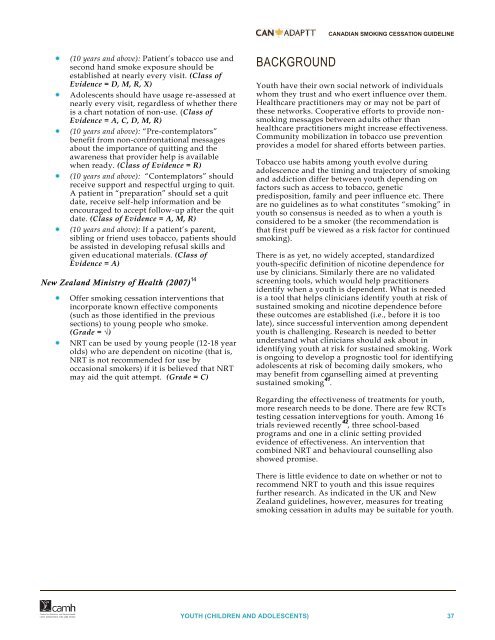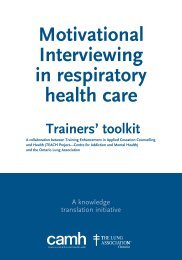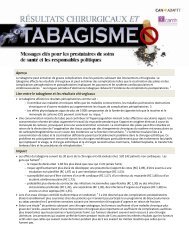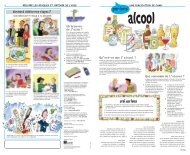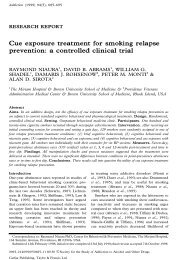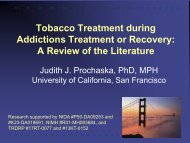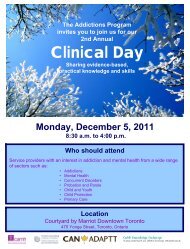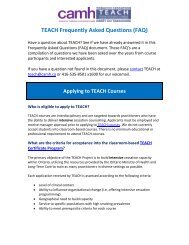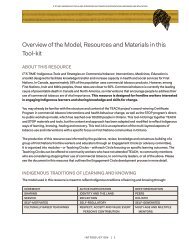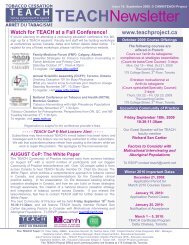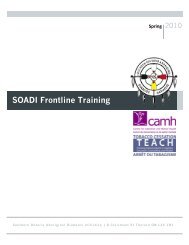Canadian Smoking Cessation Clinical Practice Guideline
Canadian Smoking Cessation Clinical Practice Guideline
Canadian Smoking Cessation Clinical Practice Guideline
You also want an ePaper? Increase the reach of your titles
YUMPU automatically turns print PDFs into web optimized ePapers that Google loves.
CANADIAN SMOKING CESSATION GUIDELINE(10 years and above): Patient’s tobacco use andsecond hand smoke exposure should beestablished at nearly every visit. (Class ofEvidence = D, M, R, X)Adolescents should have usage re-assessed atnearly every visit, regardless of whether thereis a chart notation of non-use. (Class ofEvidence = A, C, D, M, R)(10 years and above): “Pre-contemplators”benefit from non-confrontational messagesabout the importance of quitting and theawareness that provider help is availablewhen ready. (Class of Evidence = R)(10 years and above): “Contemplators” shouldreceive support and respectful urging to quit.A patient in “preparation” should set a quitdate, receive self-help information and beencouraged to accept follow-up after the quitdate. (Class of Evidence = A, M, R)(10 years and above): If a patient’s parent,sibling or friend uses tobacco, patients shouldbe assisted in developing refusal skills andgiven educational materials. (Class ofEvidence = A)New Zealand Ministry of Health (2007) 14Offer smoking cessation interventions thatincorporate known effective components(such as those identified in the previoussections) to young people who smoke.(Grade = √)NRT can be used by young people (12-18 yearolds) who are dependent on nicotine (that is,NRT is not recommended for use byoccasional smokers) if it is believed that NRTmay aid the quit attempt. (Grade = C)BACKGROUNDYouth have their own social network of individualswhom they trust and who exert influence over them.Healthcare practitioners may or may not be part ofthese networks. Cooperative efforts to provide nonsmokingmessages between adults other thanhealthcare practitioners might increase effectiveness.Community mobilization in tobacco use preventionprovides a model for shared efforts between parties.Tobacco use habits among youth evolve duringadolescence and the timing and trajectory of smokingand addiction differ between youth depending onfactors such as access to tobacco, geneticpredisposition, family and peer influence etc. Thereare no guidelines as to what constitutes “smoking” inyouth so consensus is needed as to when a youth isconsidered to be a smoker (the recommendation isthat first puff be viewed as a risk factor for continuedsmoking).There is as yet, no widely accepted, standardizedyouth-specific definition of nicotine dependence foruse by clinicians. Similarly there are no validatedscreening tools, which would help practitionersidentify when a youth is dependent. What is neededis a tool that helps clinicians identify youth at risk ofsustained smoking and nicotine dependence beforethese outcomes are established (i.e., before it is toolate), since successful intervention among dependentyouth is challenging. Research is needed to betterunderstand what clinicians should ask about inidentifying youth at risk for sustained smoking. Workis ongoing to develop a prognostic tool for identifyingadolescents at risk of becoming daily smokers, whomay benefit from counselling aimed at preventingsustained smoking 41 .Regarding the effectiveness of treatments for youth,more research needs to be done. There are few RCTstesting cessation interventions for youth. Among 16trials reviewed recently 42 , three school-basedprograms and one in a clinic setting providedevidence of effectiveness. An intervention thatcombined NRT and behavioural counselling alsoshowed promise.There is little evidence to date on whether or not torecommend NRT to youth and this issue requiresfurther research. As indicated in the UK and NewZealand guidelines, however, measures for treatingsmoking cessation in adults may be suitable for youth.YOUTH (CHILDREN AND ADOLESCENTS) 37


